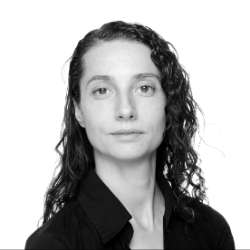The Duato | Shechter programme presented by the Staatsballett Berlin adds gloom to the very dark winter evenings in Berlin. Dealing with emptiness, loneliness and helplessness, Shechter’s and Duato’s works on familiar and environmental desolation leave a bitter aftertaste. We're greeted at the Komische Oper by a dance scholar from the Freie University, who offers an introduction to the works.
Since Duato’s appointment as artistic director in 2014, the company’s repertoire has seen an increase in the variety of styles proposed. With the London based Hofesh Shechter, Duato is following in the trend of having modern and contemporary works performed by ballet companies. Premiered in 2009, The Art of Not Looking Back presents Shechter’s typical movement vocabulary. The grounded movement quality required for his work – Shechter is a former Batsheva dancer – is diametrically opposed to the seemingly ethereal and uplifted ballet stance. In this work, he tackles the trauma of a forlorn child. On stage six women – unusual for Shechter – in brown dresses and socks, alternate between depicting the emotional landscape of the young child and that of the mother who left. In an almost perfect white box, we hear his piercing, devilish cries, together with shrieks, distorted conversations and pounding basses. The whole is so loud that it is almost painful. The dancers deform their backlit bodies against the white background in Shechter’s typical movement vocabulary, their upper bodies splendidly fluid, but their stance still a little too light on their feet. The link to the earth, typical of Shechter’s dancers, is missing. Each scene builds upon the previous one in a stratification, a crescendo of deformed images, sounds and emotions that is then undercut by some startling sound or light, allowing the audience to rest back in their seats. As a clockwork, we are brought back and forth at regular intervals by these Verfremdung effects. The strategy is used a little too often so that in the end, the emotions evaporate. Yes, in the dance, the neglect inflicted is so strong that it eventually does not allow the person to forgive. Still, as we are yet again woken up, at the end of the work, we forget the feelings evoked almost as soon as we step out for the intermission.
The second work, by Duato, is a call to avoid environmental catastrophe. Erde (English: Earth), which premiered in April this year, is an admonition of the ticking environmental clock. The dance starts with Mother Nature suddenly standing in front of the curtains alone, clad in a greenish and glittery hand-sewn unitard by Beate Borrmann. Forced into a trio dance by two bare-chested men, Nature is an unwilling witness to the destruction caused by a careless human race. In the back, a plastic veil visually distorts the movements of a group of 25 dancers. Behind what – we will discover – is a plastic cube/screen (stage design by Numen and Ivana Jonke), the dancers appear and disappear creating design patterns on music by Pedro Alcalde, Sergio Caballero, Richie Hawtin, Alva Noto and Mika Vainio. Most of Duato’s works have few yet very strong images, in this case, it is the smoke-filled cube that suddenly detaches and floats on stage, with a dancer trying to climb on top of it. The image of a barely lit stage and a startling grid of blue lasers extending from the stage over the audience’s head follows next. Unfortunately, the installation is only fleeting and not fully developed. Next is a group in blue unitards reproducing the same movements as at the beginning at the sound of a church bell. The dancers reminded me of the ocean's waves but also of birds-of-paradise with the environmental clock almost at midnight. All along, Mother Nature is observing looking at times like a glittery snake. At the end, she becomes a naked Eve/deer sleeping in a miniature wood that has rolled on stage. Duato creates astonishing scenographic images but the movement material is like a drink that has not been properly shaken.
In this programme, there is hope for the world, but none for the dysfunctional family. Even if dealing with emptiness and loneliness, both dances seemed somehow too ‘eloquent’, lacking in something. Shechter’s piece might, paraphrasing his words, have made us feel bypassing the logic of the mind but the abrupt ending left no intellectual trace, whereas Duato’s made us think, bypassing the emotions. The Staatsballett dancers have done a beautiful job in working with unusual movements qualities. If ballet has often intruded in modern and contemporary dance, now it is the opposite. And we will see more of it in the future.


